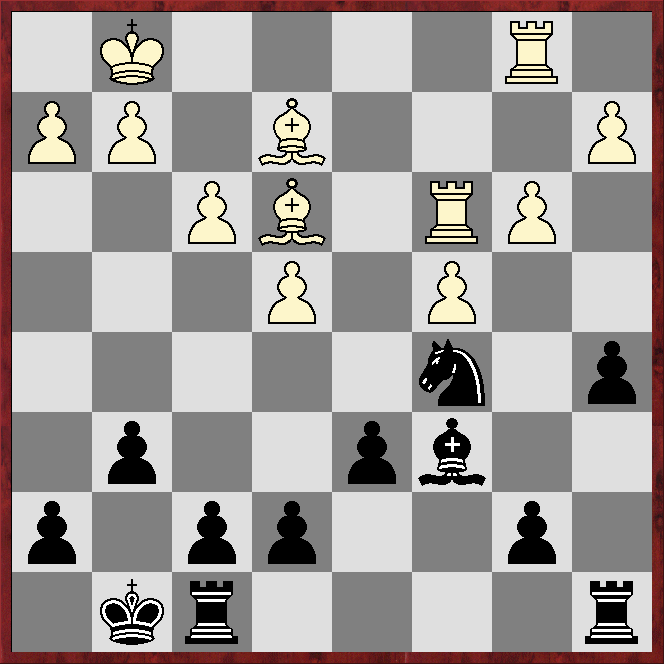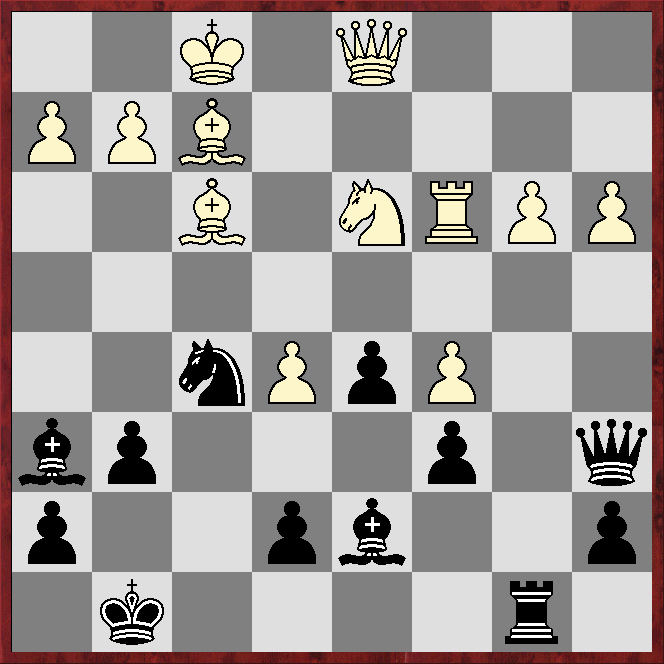FACED a Frenchman.
Patrick Chochoy (1757) - Spanton (1954)
Maróczy Bind
1.e4 c5 2.Nf3 Nc6 3.d4 cxd4 4.Nxd4 g6 5.c4
Entering the Maróczy Bind scores a very healthy 57% in ChessBase's 2025 Mega database, while the more popular 5.Nc3 returns a disappointing 49%.
5...Bg7 6.Be3 Nf6 7.Nc3 d6 8.Be2 0-0 9.0-0
 |
| This position occurs 19,854 times in Mega25 |
*****
*****
*****
*****
*****
9...Bd7 10.Qd2
The one time Géza Maróczy had the position after 9...Bd7, in a 1906 game, he played 10.h3, which had been played against him two years previously in the stem game. That also seems to be Dragon1's top choice, very marginally ahead of the unusual 10.Re1!?, although the engine does for a while prefer the text. Stockfish17 likes the trendy 10.Nc2!?, again ahead of 10.Re1!?
10...Nxd4
This is why 10.Nc2!? has become fashionable - to prevent Black reducing the cramp in the black position by initiating exchanges.
11.Bxd4 Bc6 12.f3 a5!?
The main point of this move is to secure c5 for the remaining black knight. It also gains space, but more-or-less gives up hopes Black might have of breaking the Bind, or at least challenging it, with ...b5.
13.b3 Nd7
 |
| We are still very much in mainstream theory - this position occurs 2,404 times in Mega25 |
*****
*****
*****
*****
*****
14.Be3!?
This is easily the commonest continuation, following the advice that when you have a bad bishop (White's light-square bishop is hemmed in by its own pawns) avoid exchanging your good one.
14...Nc5 15.Rab1
Again easily the main continuation.
15...Qb6!?
Self-pinning looks strange, at least at first sight, but White cannot immediately take advantage of Black's setup on the g1-a7 diagonal.
16.Rfc1
 |
| This position occurs 1,114 times in Mega25 |
*****
*****
*****
*****
*****
16...Qb4!?
The engines prefer this over the much more common 16...Rfc8.
17.Rc2
This is the usual response, but the engines suggest 17.Qb2!?
17...Bxc3!?
This unusual continuation - normal is 17...Rfc8 - is the top choice of the engines.
 |
| How should White recapture? |
*****
*****
*****
*****
*****
18.Qxc3
This lets Black follow through with the main idea of 17...Bxc3!? - getting queens off the board.
Instead, after 18.Rxc3!? it appears at first that Black can take on e4 with the bishop as 19.fxe4?? loses to 19...Nxe4, followed by snaffling the c3 rook. But White does not have to fall in with Black's plans, and can play 19.Rb2!? Bc6 20.a3!, meeting both 20...Qxa3 and 20...Qb6 with 21.b4, winning material. The engines also point out 19.a3!?, which also seems very good.
However Black does not have to play 18...Bxe4? - rather 18...Na4 forces an exchange of queens, as in the game.
18...Qxc3 19.Rxc3
 |
| How would you assess this queenless middlegame? |
*****
*****
*****
*****
*****
White has more space and the bishop-pair, although the latter factor is tempered by there being 14 pawns on the board, with all but one white pawn on the same-colour squares as White's light-square bishop. The Black knight is well-posted, for now - it faces being evicted by White playing a3 and b4. Dragon1 gives White a slight edge, but Stockfish17 calls the game equal.
19...f5?
This novelty is misdirected. Better are the known moves 19...Ne6 and 19...b6, but two other known moves - 19...Rfc8? and 19...Rfb8? - are mistakes because of the reply 20.e5.
20.exf5?!
This is good enough for an advantage, but 20.e5 is stronger, eg 20...f4 (20...dxe5?? 21.Bxc5) 21.Bf2 Rfe8 22.exd6 exd6 23.Bf1, when the isolated d pawn is a serious weakness.
20...Rxf5 21.Bxc5?!
White should almost certainly not give up the better white bishop.
21...Rxc5
The engines slightly prefer 21...dxc5!?
22.Re3 Kf7 23.f4 b6 24.Re1 e5
The engines prefer passive-looking defence with 24...Re8 or 24...Ra7.
25.fxe5
The engines give White a slight edge (Dragon1) or the better part of equality (Stockfish17) after 25.Rf1.
25...dxe5
The pawn is isolated, but passed. However the engines prefer 25...Rxe5!?
26.a3 e4 27.Bd1 Re5 28.Bc2 Rae8 29.Rd1 Kf6 30.g3!? g5 31.g4 Kg7!? 32.Rd6 R5e6 33.Rd1 Rf8
 |
| How should White proceed? |
*****
*****
*****
*****
*****
34.Rde1?!
The engines strongly dislike this, reckoning 34.b4 maintains equality (Stockfish17 is also fine with 34.h3, but Dragon1 reckons it leaves Black with a slight edge).
34...Rf4 35.h3
This looks natural, but the engines prefer 35.Bd1.
35...Kg6
The engines give 35...Kf6!? as much stronger, eg 36.Bd1 Ke5 37.Be2 Kd4 38.Bf1 a4, when suddenly White's queenside is vulnerable.
Going back to the last diagram, after the suggested 34.b4 there might come 34...axb4 35.axb4 Rf4, but 36.h3 is now fine, presumably because there is little chance of the black king attacking White's queenside.
This is really quite subtle stuff, and I do not suppose even a small fraction of it crossed either player's mind.
36.R1e2?!
The engines much prefer 36.b4 or 36.Rd1.
36...h5
They again like ...Kf6, and if 37.Rd2, then 37...Ke5, with ...Rd6 to come so the black king can gain access to the queenside.
37.gxh5+ Kxh5 38.Rg2?!
The engines suggest 38.Rd2, or 38.Bd1 followed by Rd2.
38...Rf3?
The engines reckon taking the open d file with 38...Rd6 is strong.
39.Bd1 Rd6 40.Bxf3+ Kxf3 41.Rf2
Possibly better is 41.Rg3, hoping to give back the exchange in return for the f pawn. However 41...Rd1+ 42.Kf2 Rd2+ 43.Kf1 a4!? (43...Rd1+? 44.Re1 Rd3 45.Re5) 44.bxa4 Ra2 seems to give enough counterplay.
41...g4 42.hxg4+ Kxg4
 |
| Now the f pawn is fully protected, and the position is completely equal, according to the engines, but tricky |
*****
*****
*****
*****
*****
43.Re7 Rg6?
This lets White threaten to activate his king. Instead both 43...Kf4 and 43...Kg3 keep a lid on the position, while also holding are moves such as 43...Bd7 and 43...Rd1+ (meeting 44.Re1 with 44...Rd2).
 |
| White to play and (probably) win |
*****
*****
*****
*****
*****
44.Kh2
After 44.Rh2! the only way to stop White's king getting active with 45.Kf2 is 44...Kg3, but the engines reckon 45.Reh7! wins, eg 45...Rd6 46.R2h3+ Kf4 47.R3h6! Rd1+ 48.Kf2 Rd2+ 49.Ke1 Re2+ 50.Kf1 Be4 51.Re7 Re3 52.Rh4+ Kf5 53.Rf7+ Ke6 54.Rf8 Ke7 55.Rb8 etc.
This is a difficult line to foresee, and White has to find a lot of good moves, eg 47.R7h6, instead of 47.R3h6!, does not win, eg 47... Rd1+ 48.Kf2 Rd2+ 49.Ke1 Re2+ 50.Kf1 Be4 reaches a similar position, but 51.Re6, instead of 51.Re7, can be met by 51...Bf5 52.Rf6 Rb2, with sufficient counterplay, while the alternative 51.Rxb6, which at first might be thought an improvement, can be met by, among other moves, 51...Ke3, eg 52.Rd6 (52.c5? Rc2 53.Kg1 Bf5 54.Rg3 Rc1+ 55.Kh2 Kf4 wins for Black) Rf2+ 53.Kg1 Rg2+ 54.Kf1 (not 54.Kh1?? Rg4 with ...Ke2 and f2 etc to come) Rf2+ etc.
44...Rh6+ 45.Kg1 Rg6?
Giving Black another chance to play Rh2.
46.Kh2 Rh6+ ½–½




































